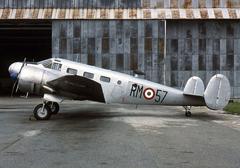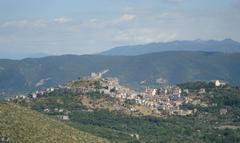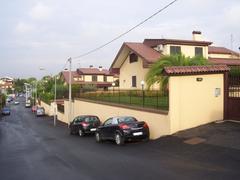Guidonia Montecelio Visiting Hours, Tickets, and Historical Sites Guide
Date: 04/07/2025
Introduction
Guidonia Montecelio, nestled just northeast of Rome in the Lazio region, is a vibrant destination where layers of Italian history, culture, and natural beauty converge. From its Etruscan roots and Roman imperial connections to its medieval fortifications and 20th-century aviation heritage, the town provides travelers with a compelling gateway to Lazio’s rich past and present. This guide delivers detailed insight into Guidonia Montecelio’s historical attractions, visiting hours, ticketing details, accessibility, and practical travel tips—offering everything you need for an enriching visit (Audiala’s Lazio Historical Sites Guide; Go Travel Daily; official municipality website).
Table of Contents
- Ancient and Pre-Roman Origins
- Roman Era and Imperial Significance
- Medieval Foundations: Montecelio
- Modern Era: The Birth and Growth of Guidonia
- World War II and Postwar Development
- Key Historical and Cultural Sites
- Natural Parks and Wellness
- Local Culture: Festivals and Gastronomy
- Modern Attractions: Shopping, Sports, and Leisure
- Day Trips and Nearby Highlights
- Visitor Information: Hours, Tickets, Accessibility, and Travel Tips
- Frequently Asked Questions (FAQ)
- Visuals and Media Recommendations
- Further Reading and Sources
Ancient and Pre-Roman Origins
Guidonia Montecelio’s territory was inhabited by the Etruscans, one of Italy’s most influential pre-Roman civilizations. Their settlements capitalized on the fertile lands and strategic location between the ancient Via Nomentana and Via Tiburtina—key routes that remain significant today (audiala.com). While direct Etruscan ruins are less visible here than in neighboring towns, their influence is still woven into the region’s cultural fabric.
Roman Era and Imperial Significance
Under Roman rule, the area became integrated into the vast network of Roman infrastructure, its location supporting trade, agriculture, and military logistics (audiala.com). The nearby UNESCO World Heritage Site, Hadrian’s Villa (Villa Adriana), constructed in the 2nd century CE as Emperor Hadrian’s luxurious retreat, is a testament to Roman opulence and innovation (wildtrips.net; thebitetour.com). Travertine quarries in the area supplied materials for iconic Roman structures, a legacy still evident in the local economy.
Medieval Foundations: Montecelio
Montecelio, the older core of the municipality, was established in 998 CE as a fortified hilltop castrum (wikipedia.org). Its narrow, winding alleys and stone houses, coupled with medieval fortifications, exemplify the defensive architecture of the era. Landmarks like the Church of San Michele Arcangelo and the Rocca di Montecelio reflect centuries-old spiritual and civic life (thebitetour.com).
Modern Era: The Birth and Growth of Guidonia
In 1915, the Italian Royal Army established a military airfield in the area, which later became a major hub for the Italian Air Force (wikipedia.org). Officially founded in 1937, the town was named after General Alessandro Guidoni, a pioneer in aviation who died while testing a parachute at the local airbase. The modern town merged with Montecelio, creating the current municipality and marking a new phase of urban and industrial expansion.
World War II and Postwar Development
During WWII, the airbase played a significant tactical role, and the town endured bombings and military occupation (audiala.com). Postwar reconstruction spurred rapid growth, with the travertine and cement industries becoming local economic pillars (wildtrips.net). Today, Guidonia Montecelio is one of the largest municipalities in the Metropolitan City of Rome, with a population approaching 90,000.
Key Historical and Cultural Sites
Hadrian’s Villa (Villa Adriana)
- Hours: Daily, 9:00 AM–7:00 PM (last entry 6:00 PM; subject to seasonal variation).
- Tickets: €12 general admission; reduced rates for EU citizens 18–25; free for children under 18 and EU seniors over 65.
- Accessibility: Wheelchair-accessible main paths; uneven terrain may limit full access.
- Tips: Visit early and pair with Parco di Villa Gregoriana for a full historical experience (wildtrips.net).
Museo Civico “Rodolfo Lanciani”
- Hours: Tuesday–Sunday, 10:00 AM–6:00 PM; closed Mondays.
- Tickets: Free or low-cost; check official site for updates.
- Highlights: Archaeological finds and artworks tracing local evolution.
Montecelio Medieval Center & Rocca di Montecelio
- Medieval Center: Open year-round as a public space. Free to explore; churches may have specific hours.
- Rocca di Montecelio: Tuesday–Sunday, 9:00 AM–6:00 PM (last entry 5:30 PM). Tickets €5 adults; reductions for children and seniors.
Villa la Torretta
- Access: By appointment only due to renovations. Photography permitted during guided tours (Villa la Torretta Property Report).
Chiesa di San Michele Arcangelo
- Hours: Daily, 8:00 AM–7:00 PM. Free entry.
Villa di Marco Simone
- Hours: Wednesday–Sunday, 10:00 AM–4:00 PM.
- Tickets: €8 adults, discounts for students/seniors. Advance booking recommended.
Aquae Albulae Thermal Springs
- Not fully developed for tourism but historically significant for their ancient therapeutic use.
Museo dell’Aeronautica Gianni Caproni & Guidonia Air Base
- Museum Hours: Tuesday–Sunday, 9:30 AM–5:00 PM. Tickets €7 adults; free for children under 12.
- Highlights: Vintage aircraft, simulators, and interactive exhibits; occasional air shows.
Natural Parks and Wellness
Parco Regionale dei Monti Lucretili
A protected area spanning over 18,000 hectares, featuring hiking and biking trails, ancient hermitages, and diverse flora and fauna.
Thermal Wellness at Terme di Tivoli
Mineral-rich thermal baths with modern spa facilities just outside Guidonia Montecelio—ideal for relaxation and wellness treatments.
Local Culture: Festivals and Gastronomy
Guidonia Montecelio’s cultural calendar is highlighted by:
- Festa di San Michele: Religious processions, music, and communal feasts (explorecity.life).
- Guidonia Jazz Festival: Summer jazz performances and workshops (explorecity.life).
- Sagra della Porchetta: Celebrating local gastronomy.
Local cuisine features Lazio specialties such as fettuccine ai funghi porcini and abbacchio alla romana, available at trattorias and agriturismi.
Modern Attractions: Shopping, Sports, and Leisure
- Centro Commerciale Tiburtino: Shopping and entertainment hub.
- Marco Simone Golf & Country Club: Host of the 2023 Ryder Cup.
- Weekly Markets: Fresh produce and artisanal goods.
Day Trips and Nearby Highlights
- Tivoli: Explore UNESCO sites Villa d’Este and Villa Adriana.
- Rome: 30 minutes by train or car.
- Other Excursions: Subiaco, Palestrina, and the lakes of Castel Gandolfo.
Visitor Information: Hours, Tickets, Accessibility, and Travel Tips
- Getting There: 25–30 km from Rome, via A24 motorway or regional trains from Tiburtina station.
- Best Time to Visit: Spring (April–June) and autumn (September–October).
- Accessibility: Most museums, parks, and public spaces are wheelchair accessible, but cobblestone streets in medieval areas may be challenging.
- Tickets: Purchase on-site or online; guided tours for major sites are recommended to book in advance.
Frequently Asked Questions (FAQ)
Q: What are the visiting hours for major sites?
A: Most open between 9:00 AM and 7:00 PM; check specific attractions for seasonal variations.
Q: How do I buy tickets for Hadrian’s Villa and other museums?
A: Online via official sites or at entrances; advance booking is wise during high season.
Q: Are there guided tours?
A: Yes, at major sites and museums; book ahead for availability.
Q: Is Guidonia Montecelio accessible for visitors with disabilities?
A: Many main attractions are accessible; some ancient or medieval areas may present challenges.
Q: Is it suitable for a day trip from Rome?
A: Yes, with excellent transport links and proximity to other Lazio highlights.
Visuals and Media Recommendations
-
Hadrian’s Villa Ruins:
Alt text: Ruins of Hadrian’s Villa near Guidonia Montecelio, Lazio historical sites -
Montecelio Medieval Center:
Alt text: Narrow medieval streets in Montecelio, Guidonia Montecelio -
Travertine Quarries:
Alt text: Travertine quarries near Guidonia Montecelio
For further interactive content, check city tourism websites for virtual tours and event videos.
Tips for Experiencing Local Culture
- Visit during major festivals like Festa di San Michele or the Jazz Festival for immersive experiences.
- Explore local markets for authentic flavors and crafts.
- Check event calendars via Eventbrite and AllEvents.
- Dress appropriately for weather and when entering churches.
Conclusion
Guidonia Montecelio stands out as a destination that effortlessly fuses ancient history, medieval ambiance, modern innovation, and vibrant local life. Its proximity to Rome and Tivoli, coupled with a wealth of cultural, natural, and recreational attractions, makes it ideal for both day-trippers and longer stays. Whether you are a history buff, culture seeker, or nature enthusiast, Guidonia Montecelio offers a multifaceted itinerary. For the latest updates, download the Audiala app, explore related articles, and follow local tourism channels.
Sources and Further Reading
- Guidonia Montecelio Historical Sites: Visiting Hours, Tickets, and Travel Guide, Audiala
- Guidonia Montecelio: Visiting Hours, Tickets, and Exploring Lazio’s Historical Sites, Go Travel Daily
- Guidonia Montecelio Historical Sites and Visitor Guide: Top Attractions, Visiting Hours, and Travel Tips, Wild Trips
- Guidonia Montecelio Cultural Events and Visitor Guide: Visiting Hours, Tickets & Historical Sites, ExploreCity.life
- Guidonia Montecelio - Wikipedia
- Tivoli and Guidonia Demonstrations, Globalist
- Lazio Festival and Events, Italia-Italy
- Villa la Torretta Property Report
- Guidonia Montecelio Event Listings, Eventbrite
- Guide to Lazio Historical Sites, Audiala


